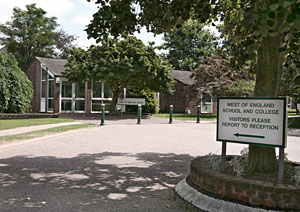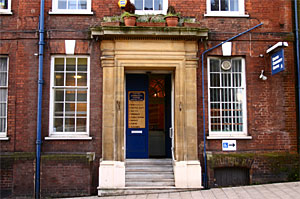
The West of England School for Young People with Little or No Sight
Page updated 20 October 2008
In 1838, John Bacon with Mrs Sarah Friend called a meeting to establish a school for the blind in Exeter.
Mrs Friend had been aware of the need for such an institution after she had instructed six blind children on the gospels using the Lucas System. Initially named, The West of England Institute for the Instruction and Employment of the Blind, it was situated in a room, hired for the sum of 20 guineas per year, at the Athenaeum, Bedford Circus. The school was innovative for its time and the staff tried different methods of reading, and eventually adopted the use of stenographic characters and raised Roman capitals.
Between 1840 and 1843, the school was housed in premises in Paul Street, that were paid for by public subscription. The school flourished as the city's blind were encouraged to attend by local doctors and clergymen. The first teacher to be employed earned 12 shillings (60 pence) per week, and basket-making and stocking-knitting were introduced activities.
The Paul Street premises were soon outgrown, and the school moved, in 1843, to a donated house in St David's Hill. It was supported by subscriptions, donations and the pupils paying for their board. Whites Devonshire Directory lists Mrs Friend as the Superintendent in 1850, at a time when the school had 17 pupils learning to read and make baskets. In addition, they could learn music, mat making and worsted work. Other members of staff at this time were the Rev. W. Jackson as chaplain, the Rev. M. Tucker as secretary, and Mr. G.H. Harvey, as the honorary musical instructor. Mr. Dean and Susan Nicholls were teachers of basket work. Mrs Friend remained as Superintendent until her death in 1875.
Music was added to the curriculum and many pupils learnt to use a specially developed, raised music notation and some even went on to become piano tuners. In 1893, a school room was built at the St David's Hill site to accommodate 20 boys and 20 girls. This is now the St David's Hill Community Centre, although there are plans to develop the site for housing.
The 20th Century
By 1911, the numbers had risen to 70 children and 12 adults. The school continued to prosper and by 1930, there were 188 blind persons registered, of which 73 were elementary pupils, 8 technical pupils, 20 workshop employees, 50 home workers and 4 with other employment.
In 1944, after the Education Act required that the blind and partially sighted be educated separately, the blind children were transferred to the Bristol Blind School, and the St David's Hill school renamed the West of England School for the Partially Sighted. In 1965, the school moved to a site at Countess Wear that incorporated a Nursery, Main School, College and St David's House.
The non-maintained school and college for blind and partially sighted pupils now caters for pupils between the age of 2 to 19+ years. The school/college has weekly/termly boarding and day facilities, along with provision for young people with additional learning difficulties and disabilities.
 The attractive, village like West of England
School.
The attractive, village like West of England
School.
 The entarnce to the St David's
Hill building that was once the School for the Blind.
The entarnce to the St David's
Hill building that was once the School for the Blind.
│ Top of Page │